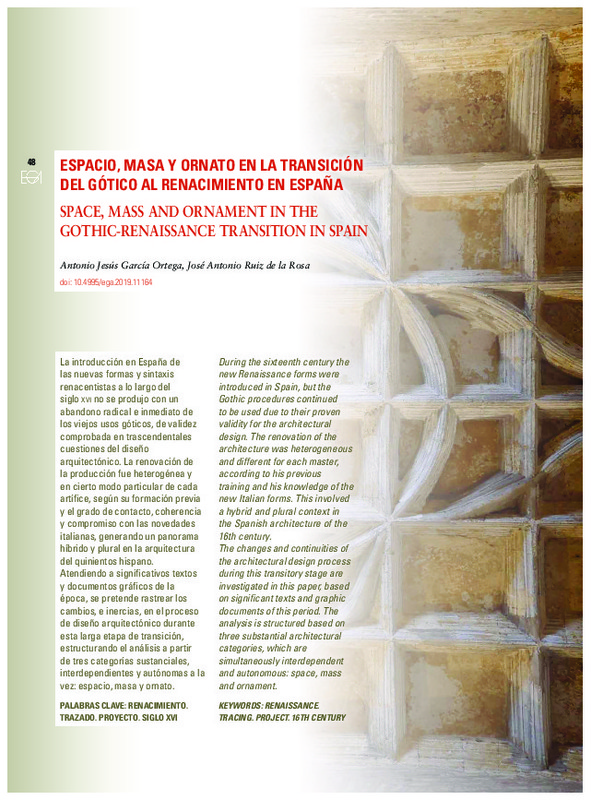JavaScript is disabled for your browser. Some features of this site may not work without it.
Buscar en RiuNet
Listar
Mi cuenta
Estadísticas
Ayuda RiuNet
Admin. UPV
Espacio, masa y ornato en la transición del Gótico al Renacimiento en España
Mostrar el registro sencillo del ítem
Ficheros en el ítem
| dc.contributor.author | García-Ortega, Antonio-Jesús
|
es_ES |
| dc.contributor.author | Ruiz de la Rosa, José Antonio
|
es_ES |
| dc.coverage.spatial | east=-3.7492200000000366; north=40.46366700000001; name=Paseo del Marqués de Monistrol, 28023 Madrid, Espanya | es_ES |
| dc.date.accessioned | 2019-07-23T09:39:10Z | |
| dc.date.available | 2019-07-23T09:39:10Z | |
| dc.date.issued | 2019-07-22 | |
| dc.identifier.issn | 1133-6137 | |
| dc.identifier.uri | http://hdl.handle.net/10251/124011 | |
| dc.description.abstract | [EN] During the sixteenth century the new Renaissance forms were introduced in Spain, but the Gothic procedures continued to be used due to their proven validity for the architectural design. The renovation of the architecture was heterogeneous and different for each master, according to his previous training and his knowledge of the new Italian forms. This involved a hybrid and plural context in the Spanish architecture of the 16th century. The changes and continuities of the architectural design process during this transitory stage are investigated in this paper, based on significant texts and graphic documents of this period. The analysis is structured based on three substantial architectural categories, which are simultaneously interdependent and autonomous: space, mass and ornament. | es_ES |
| dc.description.abstract | [ES] La introducción en España de las nuevas formas y sintaxis renacentistas a lo largo del siglo xvi no se produjo con un abandono radical e inmediato de los viejos usos góticos, de validez comprobada en trascendentales cuestiones del diseño arquitectónico. La renovación de la producción fue heterogénea y en cierto modo particular de cada artífice, según su formación previa y el grado de contacto, coherencia y compromiso con las novedades italianas, generando un panorama híbrido y plural en la arquitectura del quinientos hispano. Atendiendo a significativos textos y documentos gráficos de la época, se pretende rastrear los cambios, e inercias, en el proceso de diseño arquitectónico durante esta larga etapa de transición, estructurando el análisis a partir de tres categorías sustanciales, interdependientes y autónomas a la vez: espacio, masa y ornato. | es_ES |
| dc.language | Español | es_ES |
| dc.language | Inglés | es_ES |
| dc.publisher | Universitat Politècnica de València | |
| dc.relation.ispartof | EGA. Revista de Expresión Gráfica Arquitectónica | |
| dc.rights | Reconocimiento - No comercial - Sin obra derivada (by-nc-nd) | es_ES |
| dc.subject | Renacimiento | es_ES |
| dc.subject | Trazado | es_ES |
| dc.subject | Proyecto | es_ES |
| dc.subject | Siglo XVI | es_ES |
| dc.subject | Renaissance | es_ES |
| dc.subject | Tracing | es_ES |
| dc.subject | Project | es_ES |
| dc.subject | 16th century | es_ES |
| dc.title | Espacio, masa y ornato en la transición del Gótico al Renacimiento en España | es_ES |
| dc.title.alternative | Space, mass and ornament in the gotihc-renaissance transition in Spain | es_ES |
| dc.type | Artículo | es_ES |
| dc.date.updated | 2019-07-23T07:53:09Z | |
| dc.identifier.doi | 10.4995/ega.2019.11164 | |
| dc.rights.accessRights | Abierto | es_ES |
| dc.description.bibliographicCitation | García-Ortega, A.; Ruiz De La Rosa, JA. (2019). Espacio, masa y ornato en la transición del Gótico al Renacimiento en España. EGA. Revista de Expresión Gráfica Arquitectónica. 24(36):48-59. https://doi.org/10.4995/ega.2019.11164 | es_ES |
| dc.description.accrualMethod | SWORD | es_ES |
| dc.relation.publisherversion | https://doi.org/10.4995/ega.2019.11164 | es_ES |
| dc.description.upvformatpinicio | 48 | es_ES |
| dc.description.upvformatpfin | 59 | es_ES |
| dc.type.version | info:eu-repo/semantics/publishedVersion | es_ES |
| dc.description.volume | 24 | |
| dc.description.issue | 36 | |
| dc.identifier.eissn | 2254-6103 |








